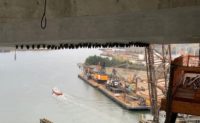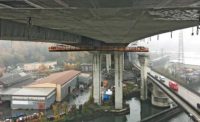The emergency stabilization of the 36-year-old West Seattle Bridge reached a new milestone after external post-tensioning and the release of a damaged Pier 18 bearing was completed Nov. 10, allowing crews to move toward wrapping girders in carbon fiber.
The Seattle Dept. of Transportation closed the bridge in March due to cracks. Kraemer North America was hired under an emergency contract to stabilize the structure. WSP provided the engineering.
Before the bulging and damaged bearing at Pier 18 could be released, Kraemer added external post-tensioning to support the existing internal post-tensioning system. The new strands run along the bottom of the girder interiors between post-tensioning brackets and through deviator blocks to help stabilize the bridge. Upon installation, which included bolting the new strands to brackets inside the girders between piers 15 and 18, crews tightened them 10%, allowing the bridge to move during the bearing release. Following the successful release of the bearing, the strands were fully tightened. They are designed to help prevent further cracking on the 2,600-ft-long high-rise structure crossing the Duwamish River between West Seattle and Harbor Island.
Kraemer will also replace the lateral bearings on the east end of the bridge that allow the bridge to expand and contract with temperature and loading changes. The bearings—rectangular pieces of synthetic rubber neoprene—act as a cushion to separate the box girder from the column cap. The bearings at Pier 18 became compressed and bulged, restricting movement of the bridge and creating additional pressure on the surrounding area, transferring stress through the bridge.
The next step will be to wrap girders in carbon fiber to provide additional strength.
Metal fabricator Vigor supported Kraemer by crafting the structural steel for the temporary access platforms and creating the 48 steel brackets, each weighing between 3,500 and 4,500 pounds, for the post-tensioning. Vigor, which builds and repairs boats on Harbor Island in the shadow of the bridge, had a “vested interest in preserving safety,” says Chris Palmer, Vigor’s vice president of production fabrication.
Seattle Mayor Jenny Durkan is still weighing her options on the future of the bridge. With HNTB, a task force has conducted a cost-benefit analysis on the options, which now include a full repair, superstructure replacement, full replacement or a tunnel. Durkan will host a virtual town hall on Nov. 16 to get feedback from the community. The final decision rests with Durkan.
No matter the conclusion, emergency work continues and SDOT expects the bridge to remain closed through 2021.






Post a comment to this article
Report Abusive Comment